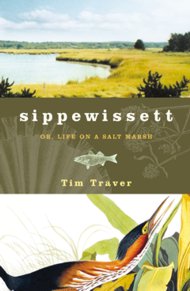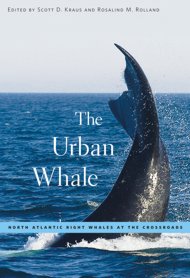
Book Reviews
Printer Friendly Page
Inspiration from a salt marsh
By Lee Bumsted
 |
Sippewissett: Or, Life on a Salt Marsh |
As a boy, Tim Traver passed idyllic summer days poking around the tidal creeks and mudflats of Sippewissett, Massachusetts. He was just vaguely aware of the researchers in white lab coats or cutoff jeans who also visited his favorite haunts. Later, he discovered the importance of the community of grasses, invertebrates, microbes, fish, and birds next to his parents' summer home. "For a dozen years or so beginning in the early 1970s, Sippewissett was the most intensively studied salt marsh in the world," he writes in Sippewissett: Or, Life on a Salt Marsh.
The Great Sippewissett Marsh attracted scientists from nearby Woods Hole Oceanographic Institution, a center for studying the marine environment. Traver notes that Rachel Carson often visited the marsh, and drew inspiration from it. This salt marsh is important on a different level to Traver, who now visits with his own family. It is part and parcel of what "home" means to him; it is a place he knows well and wants to protect.
In Sippewissett, Traver combines his personal history with that of the marsh. He celebrates time spent with his family fishing, snorkeling, kayaking in the moonlight, or just digging in the mud. He describes his encounters with some of the marsh's inhabitants and explains how the marsh functions.
Traver intersperses stories of marine biologists and naturalists who have researched the marsh, and he muses on the meaning of home and the role stewardship plays in saving it. This is a lot to pack into a small book, but most of the transitions from one topic to the next are made smoothly.
Traver, a free-lance writer with a background in environmental science and education, clearly conveys the significance of his neighborhood salt marsh and his bond to it. Illustrator Bobbi Angell's delicate drawings of salt marsh plants and animals add to the charm of this book.
Lee Bumsted writes on conservation and outdoor recreation topics from South Portland, Maine.
Right whales are threatened, but scientists are hopeful
By Lee Bumsted
 |
The Urban Whale: |
Some readers might be put off by a book of nearly 600 pages written by a group of 35 scientists, but they shouldn't be, at least in the case of The Urban Whale: North Atlantic Right Whales at the Crossroads. Those who have seen a whale, or hope to see one someday, will find much of interest in this comprehensive resource on North Atlantic right whales. Granted, some may want to leave the more technical chapters to marine scientists and students. Yet there are captivating descriptions of right whale behavior and clear, concise summaries throughout this book, as well as 32 pages of color photographs and illustrations.
Endangered North Atlantic right whales face a variety of threats including ship strikes and fishing gear entanglements. Their entire population hovers around 350 individuals. Editors Scott Kraus and Rosalind Rolland call them "urban whales" because they tend to live within 160 kilometers (99 miles) of the industrialized eastern coast of North America, where some of these threats are concentrated. Both Kraus and Rolland work at the New England Aquarium, Kraus as director of the Edgerton Research Laboratory and Rolland as senior scientist/policy analyst in the Global Marine Programs. Other contributors to this well-organized book hail from the Woods Hole Oceanographic Institution, the National Marine Fisheries Service, the Provincetown Center for Coastal Studies, and several universities in the United States and Canada.
Each chapter begins with a researcher's encounter with a particular whale. These narratives place the reader right in the boat alongside the scientists. One writer tells of playing a recording of whale sounds in hopes of attracting one, and her amazement when one quickly swims directly toward her vessel and surfaces just 30 meters (98 feet) away. In a sadder tale, Rolland and Kraus describe several unsuccessful attempts in 2001 to remove the embedded fishing line that kept a whale named Churchill from feeding. The whale died slowly of infection.
In addition to the well-written introduction and summary, 15 chapters describe what is known, and yet to be discovered, about North Atlantic right whale biology and natural history. Topics include how they eat, communicate, and move between summer and winter habitats. Threats to their health, such as fishing gear entanglements, ship strikes, toxins, and climate change, are the subjects of other sections. More technical chapters focus on survey methods, reproduction rates, and assessment of genetic data. There is also a historical review of 900 years of right whale hunting.
One chapter describes the North Atlantic Right Whale Catalog, a collaborative database that is curated by the New England Aquarium. Because the population of these right whales is so small, being able to document sightings of individuals over time is particularly important in studying them. Right whales often are identified by their facial features. The raised skin tissues on their heads, called callosities, form distinctive patterns. Scars from entanglements, ship strikes, or bite marks further aid in their identification.
Photographs of right whales are taken from research ships and small planes. The catalog contains more than 33,000 photographed sightings since 1935. Over the past 25 years, 459 individual whales have been identified and given numbers and sometimes names. Their names may be based on their callosity pattern, their scars, or their observed behavior. Shackleton was named after the Antarctic explorer, since the juvenile whale strayed into the Delaware River, well off the usual course. His distinctive pattern led to a confirmed sighting of him in the Bay of Fundy, a year and a half after being hit by a tugboat in the river. More information about the photo-identification process and the catalog is available at http://www.neaq.org/rwcatalog.
There is still a great deal to be learned about North Atlantic right whales. Biologists are trying to determine where noncalving whales spend the winter, how members of such a small population find each other, and how they detect the large aggregations of the zooplankton they eat. Further research will provide data needed to help minimize the human activities that endanger them.
Kraus and Rolland note that shipping lanes in the Bay of Fundy were shifted east in 2003 to reduce the likelihood of ship strikes, and they highlight other actions that have been taken, and can be taken, to reduce right whale deaths. They cite models that indicate that preventing the deaths of just two female whales per year could lead to an increase in the North Atlantic right whale population, and they believe this is an achievable goal. While a good portion of The Urban Whale describes threats to right whales, it is ultimately a hopeful book.
Lee Bumsted writes on conservation and outdoor recreation topics from South Portland, Maine.
© 2007 The Gulf of Maine Times